Organisational Behaviour Case Study: Workplace Dynamics Analysis
VerifiedAdded on 2022/11/22
|8
|1910
|222
Case Study
AI Summary
This case study examines the organisational behaviour within a factory, focusing on a group of young employees in the water removing section. The group exhibits strong internal cohesion, forming its own norms, manipulating work time, and often disregarding factory rules. The study analyzes how factors like age, work environment, low wages, and lack of supervision influence their behaviour. It explores the positive aspects of their cohesion, such as mutual support, alongside the negative impacts on productivity, rule adherence, and overall factory performance. The analysis highlights the importance of effective leadership, clear communication, and fair management practices. The case concludes with recommendations to improve the situation, including assigning a supervisor, establishing clear rules, increasing wages, providing incentives, and fostering employee engagement. The case underscores the significance of understanding group dynamics, employee needs, and the role of management in shaping a positive and productive work environment, with the ultimate goal of aligning employee behaviour with organizational goals. This assignment is contributed by a student to be published on the website Desklib, which provides all the necessary AI based study tools for students.
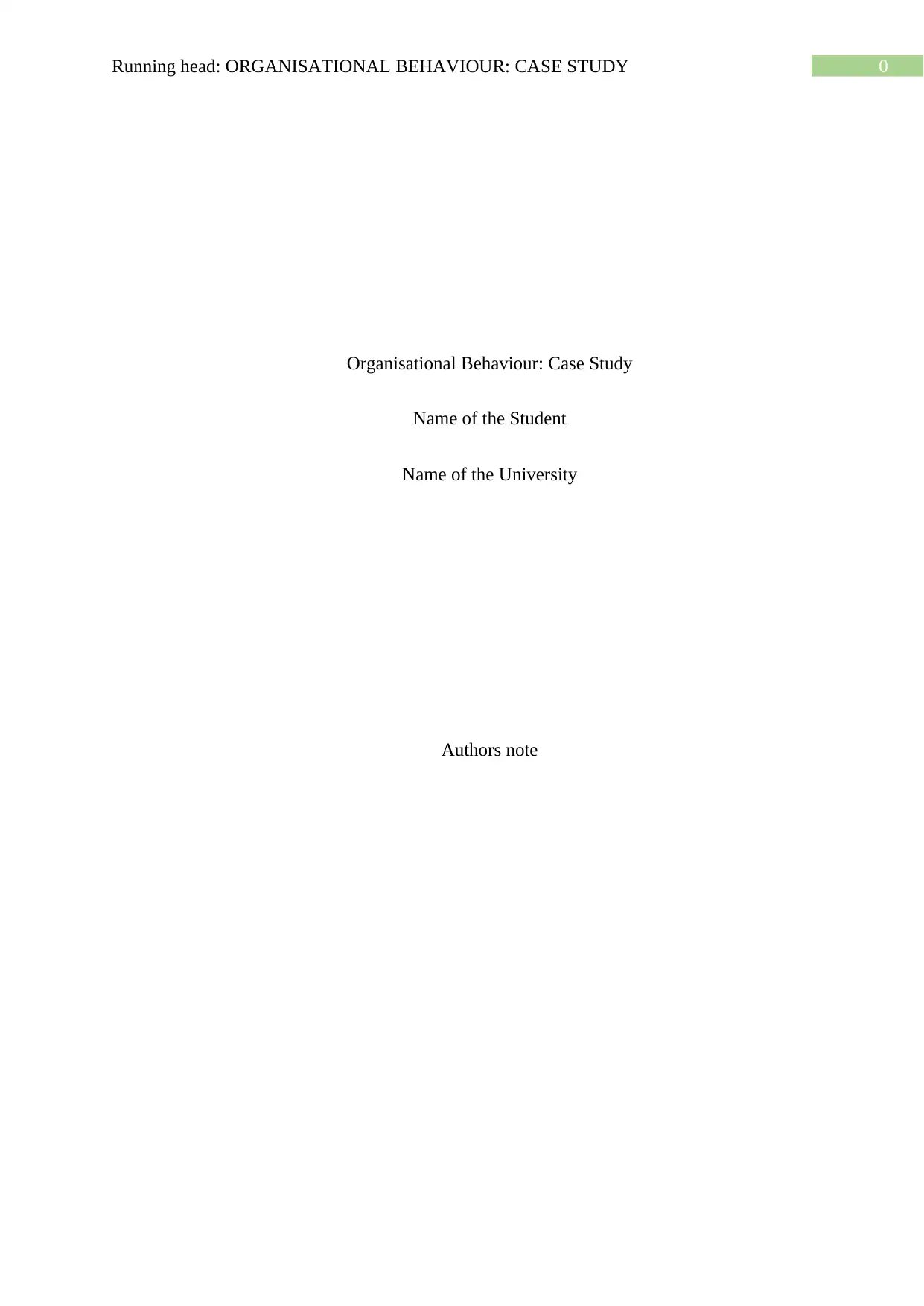
0Running head: ORGANISATIONAL BEHAVIOUR: CASE STUDY
Organisational Behaviour: Case Study
Name of the Student
Name of the University
Authors note
Organisational Behaviour: Case Study
Name of the Student
Name of the University
Authors note
Paraphrase This Document
Need a fresh take? Get an instant paraphrase of this document with our AI Paraphraser
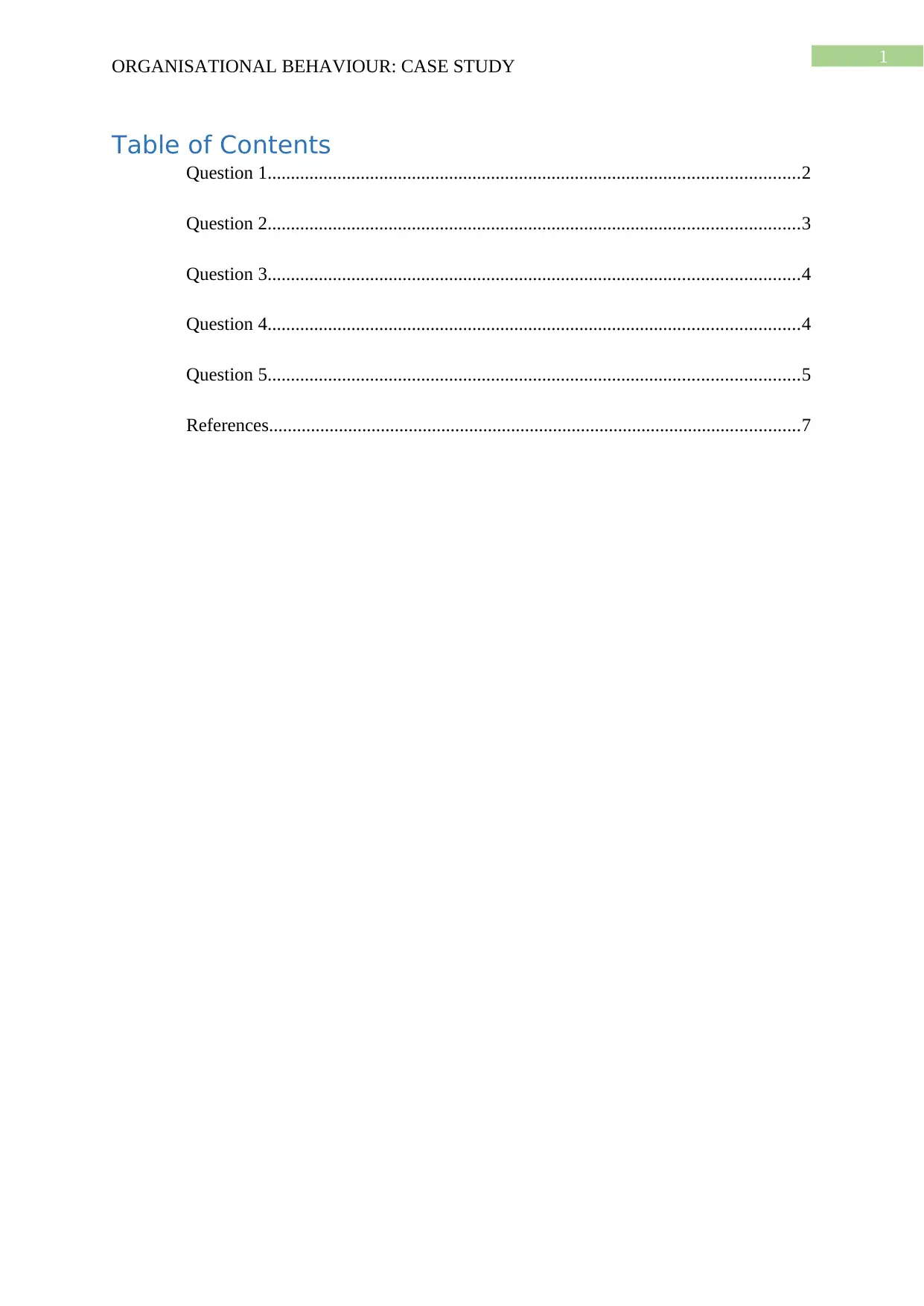
1
ORGANISATIONAL BEHAVIOUR: CASE STUDY
Table of Contents
Question 1..................................................................................................................2
Question 2..................................................................................................................3
Question 3..................................................................................................................4
Question 4..................................................................................................................4
Question 5..................................................................................................................5
References..................................................................................................................7
ORGANISATIONAL BEHAVIOUR: CASE STUDY
Table of Contents
Question 1..................................................................................................................2
Question 2..................................................................................................................3
Question 3..................................................................................................................4
Question 4..................................................................................................................4
Question 5..................................................................................................................5
References..................................................................................................................7
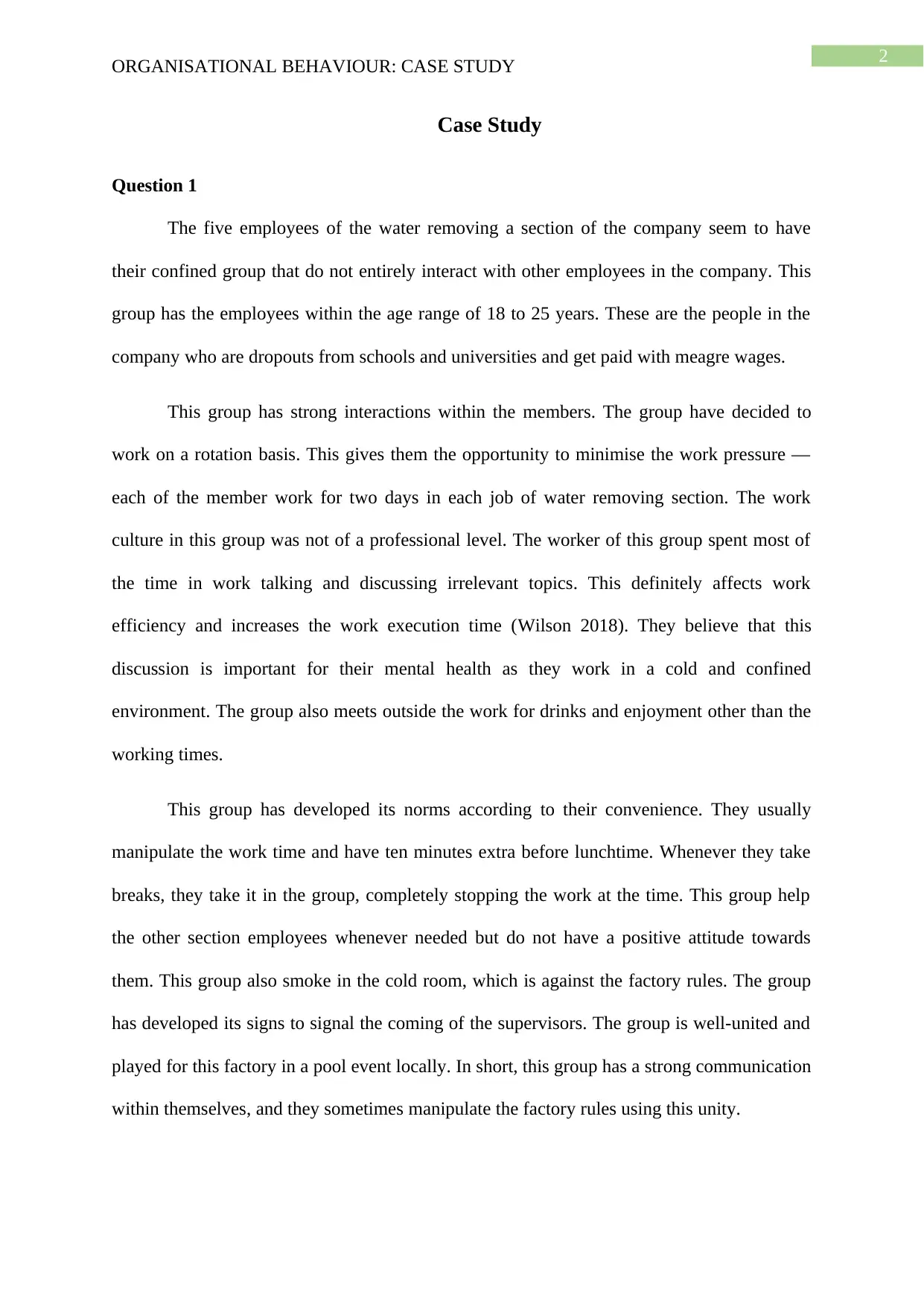
2
ORGANISATIONAL BEHAVIOUR: CASE STUDY
Case Study
Question 1
The five employees of the water removing a section of the company seem to have
their confined group that do not entirely interact with other employees in the company. This
group has the employees within the age range of 18 to 25 years. These are the people in the
company who are dropouts from schools and universities and get paid with meagre wages.
This group has strong interactions within the members. The group have decided to
work on a rotation basis. This gives them the opportunity to minimise the work pressure —
each of the member work for two days in each job of water removing section. The work
culture in this group was not of a professional level. The worker of this group spent most of
the time in work talking and discussing irrelevant topics. This definitely affects work
efficiency and increases the work execution time (Wilson 2018). They believe that this
discussion is important for their mental health as they work in a cold and confined
environment. The group also meets outside the work for drinks and enjoyment other than the
working times.
This group has developed its norms according to their convenience. They usually
manipulate the work time and have ten minutes extra before lunchtime. Whenever they take
breaks, they take it in the group, completely stopping the work at the time. This group help
the other section employees whenever needed but do not have a positive attitude towards
them. This group also smoke in the cold room, which is against the factory rules. The group
has developed its signs to signal the coming of the supervisors. The group is well-united and
played for this factory in a pool event locally. In short, this group has a strong communication
within themselves, and they sometimes manipulate the factory rules using this unity.
ORGANISATIONAL BEHAVIOUR: CASE STUDY
Case Study
Question 1
The five employees of the water removing a section of the company seem to have
their confined group that do not entirely interact with other employees in the company. This
group has the employees within the age range of 18 to 25 years. These are the people in the
company who are dropouts from schools and universities and get paid with meagre wages.
This group has strong interactions within the members. The group have decided to
work on a rotation basis. This gives them the opportunity to minimise the work pressure —
each of the member work for two days in each job of water removing section. The work
culture in this group was not of a professional level. The worker of this group spent most of
the time in work talking and discussing irrelevant topics. This definitely affects work
efficiency and increases the work execution time (Wilson 2018). They believe that this
discussion is important for their mental health as they work in a cold and confined
environment. The group also meets outside the work for drinks and enjoyment other than the
working times.
This group has developed its norms according to their convenience. They usually
manipulate the work time and have ten minutes extra before lunchtime. Whenever they take
breaks, they take it in the group, completely stopping the work at the time. This group help
the other section employees whenever needed but do not have a positive attitude towards
them. This group also smoke in the cold room, which is against the factory rules. The group
has developed its signs to signal the coming of the supervisors. The group is well-united and
played for this factory in a pool event locally. In short, this group has a strong communication
within themselves, and they sometimes manipulate the factory rules using this unity.
⊘ This is a preview!⊘
Do you want full access?
Subscribe today to unlock all pages.

Trusted by 1+ million students worldwide
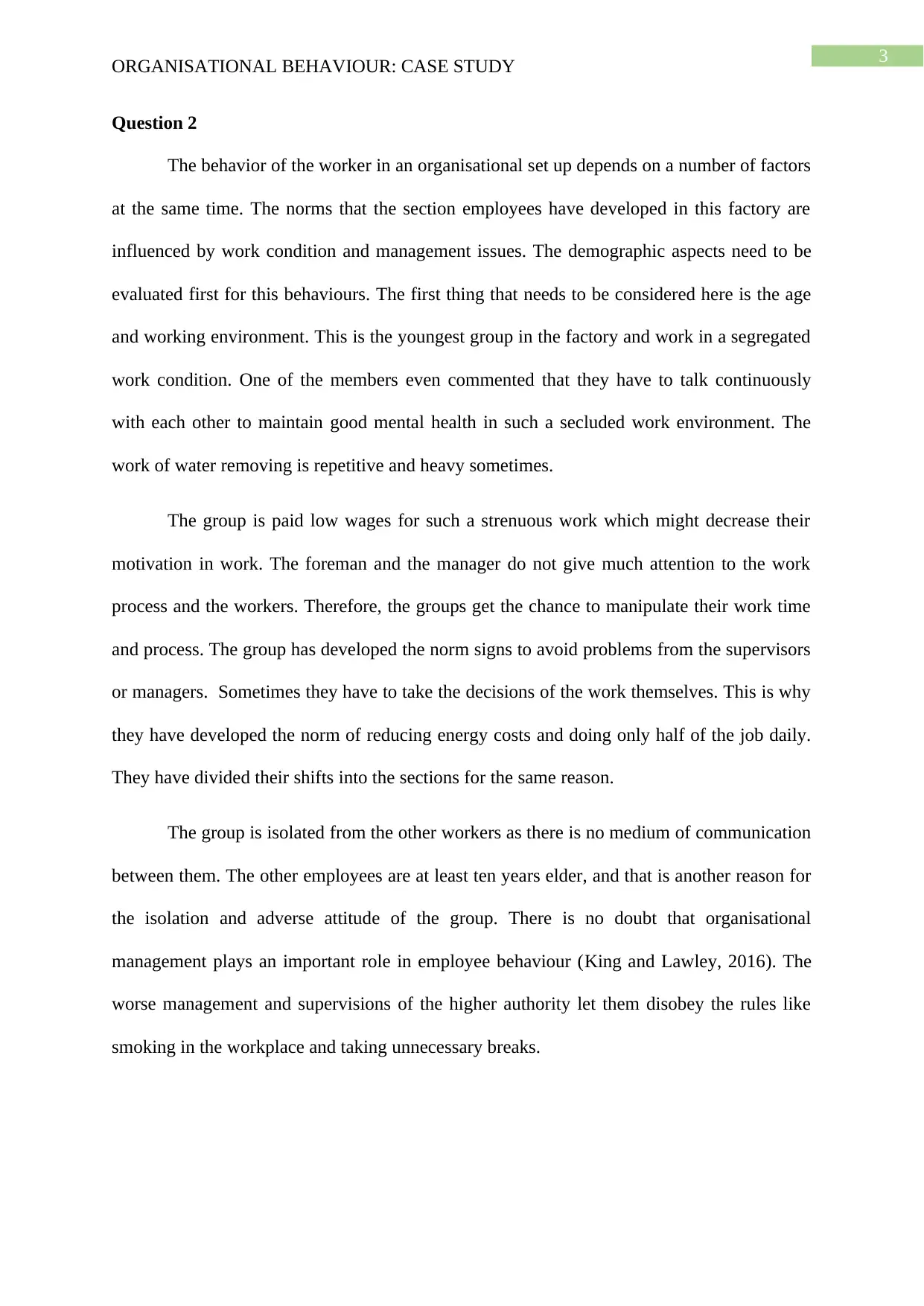
3
ORGANISATIONAL BEHAVIOUR: CASE STUDY
Question 2
The behavior of the worker in an organisational set up depends on a number of factors
at the same time. The norms that the section employees have developed in this factory are
influenced by work condition and management issues. The demographic aspects need to be
evaluated first for this behaviours. The first thing that needs to be considered here is the age
and working environment. This is the youngest group in the factory and work in a segregated
work condition. One of the members even commented that they have to talk continuously
with each other to maintain good mental health in such a secluded work environment. The
work of water removing is repetitive and heavy sometimes.
The group is paid low wages for such a strenuous work which might decrease their
motivation in work. The foreman and the manager do not give much attention to the work
process and the workers. Therefore, the groups get the chance to manipulate their work time
and process. The group has developed the norm signs to avoid problems from the supervisors
or managers. Sometimes they have to take the decisions of the work themselves. This is why
they have developed the norm of reducing energy costs and doing only half of the job daily.
They have divided their shifts into the sections for the same reason.
The group is isolated from the other workers as there is no medium of communication
between them. The other employees are at least ten years elder, and that is another reason for
the isolation and adverse attitude of the group. There is no doubt that organisational
management plays an important role in employee behaviour (King and Lawley, 2016). The
worse management and supervisions of the higher authority let them disobey the rules like
smoking in the workplace and taking unnecessary breaks.
ORGANISATIONAL BEHAVIOUR: CASE STUDY
Question 2
The behavior of the worker in an organisational set up depends on a number of factors
at the same time. The norms that the section employees have developed in this factory are
influenced by work condition and management issues. The demographic aspects need to be
evaluated first for this behaviours. The first thing that needs to be considered here is the age
and working environment. This is the youngest group in the factory and work in a segregated
work condition. One of the members even commented that they have to talk continuously
with each other to maintain good mental health in such a secluded work environment. The
work of water removing is repetitive and heavy sometimes.
The group is paid low wages for such a strenuous work which might decrease their
motivation in work. The foreman and the manager do not give much attention to the work
process and the workers. Therefore, the groups get the chance to manipulate their work time
and process. The group has developed the norm signs to avoid problems from the supervisors
or managers. Sometimes they have to take the decisions of the work themselves. This is why
they have developed the norm of reducing energy costs and doing only half of the job daily.
They have divided their shifts into the sections for the same reason.
The group is isolated from the other workers as there is no medium of communication
between them. The other employees are at least ten years elder, and that is another reason for
the isolation and adverse attitude of the group. There is no doubt that organisational
management plays an important role in employee behaviour (King and Lawley, 2016). The
worse management and supervisions of the higher authority let them disobey the rules like
smoking in the workplace and taking unnecessary breaks.
Paraphrase This Document
Need a fresh take? Get an instant paraphrase of this document with our AI Paraphraser
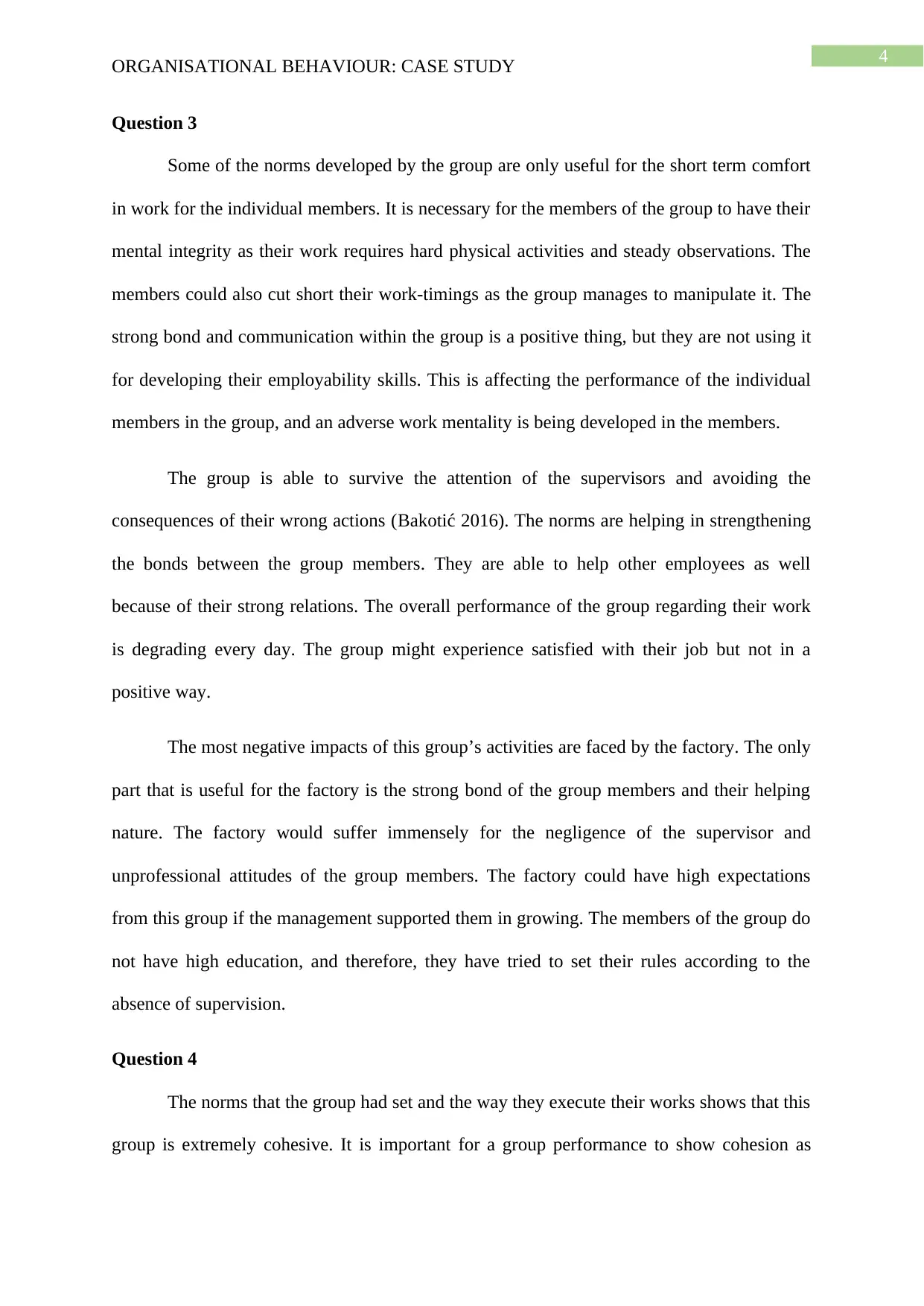
4
ORGANISATIONAL BEHAVIOUR: CASE STUDY
Question 3
Some of the norms developed by the group are only useful for the short term comfort
in work for the individual members. It is necessary for the members of the group to have their
mental integrity as their work requires hard physical activities and steady observations. The
members could also cut short their work-timings as the group manages to manipulate it. The
strong bond and communication within the group is a positive thing, but they are not using it
for developing their employability skills. This is affecting the performance of the individual
members in the group, and an adverse work mentality is being developed in the members.
The group is able to survive the attention of the supervisors and avoiding the
consequences of their wrong actions (Bakotić 2016). The norms are helping in strengthening
the bonds between the group members. They are able to help other employees as well
because of their strong relations. The overall performance of the group regarding their work
is degrading every day. The group might experience satisfied with their job but not in a
positive way.
The most negative impacts of this group’s activities are faced by the factory. The only
part that is useful for the factory is the strong bond of the group members and their helping
nature. The factory would suffer immensely for the negligence of the supervisor and
unprofessional attitudes of the group members. The factory could have high expectations
from this group if the management supported them in growing. The members of the group do
not have high education, and therefore, they have tried to set their rules according to the
absence of supervision.
Question 4
The norms that the group had set and the way they execute their works shows that this
group is extremely cohesive. It is important for a group performance to show cohesion as
ORGANISATIONAL BEHAVIOUR: CASE STUDY
Question 3
Some of the norms developed by the group are only useful for the short term comfort
in work for the individual members. It is necessary for the members of the group to have their
mental integrity as their work requires hard physical activities and steady observations. The
members could also cut short their work-timings as the group manages to manipulate it. The
strong bond and communication within the group is a positive thing, but they are not using it
for developing their employability skills. This is affecting the performance of the individual
members in the group, and an adverse work mentality is being developed in the members.
The group is able to survive the attention of the supervisors and avoiding the
consequences of their wrong actions (Bakotić 2016). The norms are helping in strengthening
the bonds between the group members. They are able to help other employees as well
because of their strong relations. The overall performance of the group regarding their work
is degrading every day. The group might experience satisfied with their job but not in a
positive way.
The most negative impacts of this group’s activities are faced by the factory. The only
part that is useful for the factory is the strong bond of the group members and their helping
nature. The factory would suffer immensely for the negligence of the supervisor and
unprofessional attitudes of the group members. The factory could have high expectations
from this group if the management supported them in growing. The members of the group do
not have high education, and therefore, they have tried to set their rules according to the
absence of supervision.
Question 4
The norms that the group had set and the way they execute their works shows that this
group is extremely cohesive. It is important for a group performance to show cohesion as
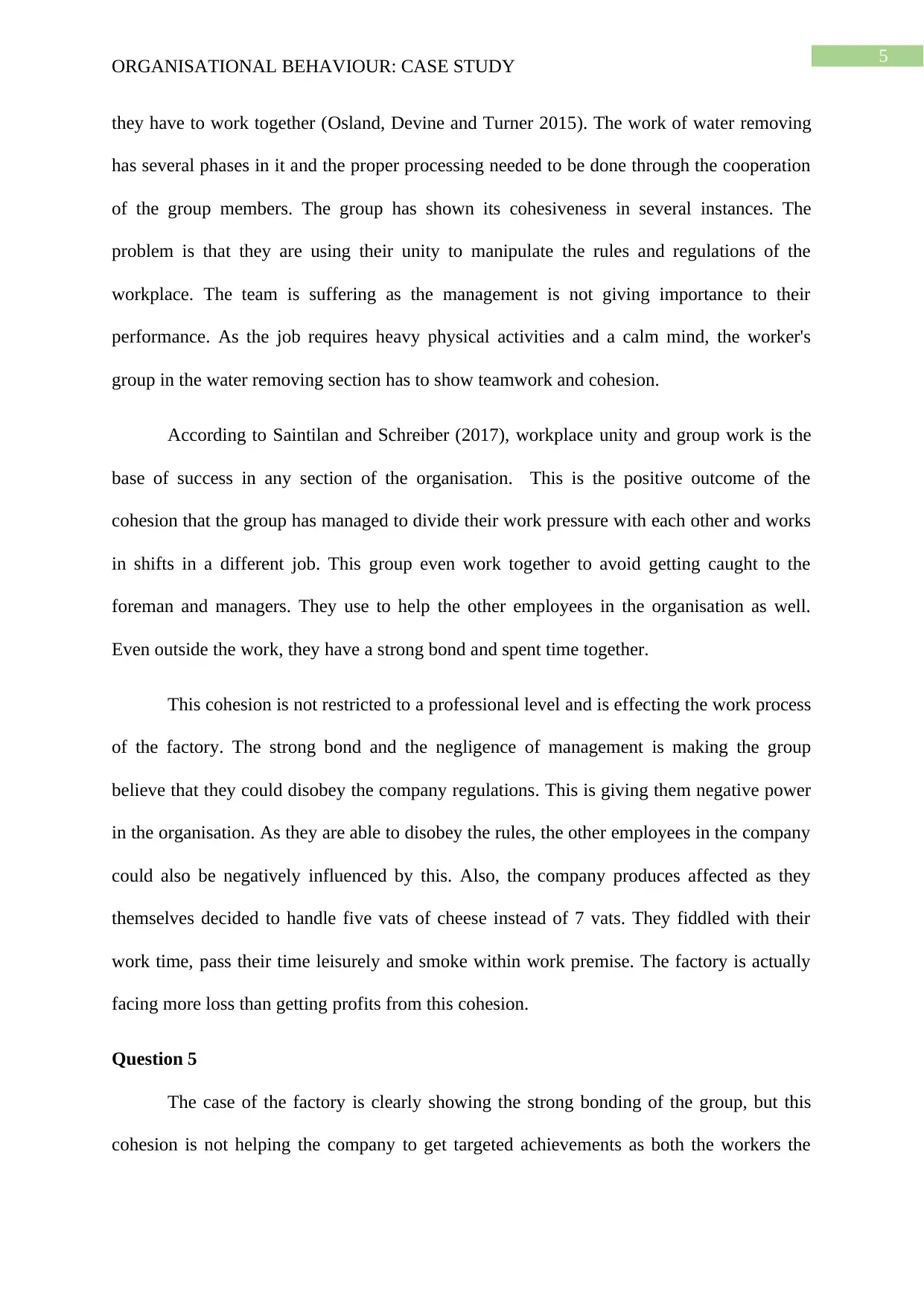
5
ORGANISATIONAL BEHAVIOUR: CASE STUDY
they have to work together (Osland, Devine and Turner 2015). The work of water removing
has several phases in it and the proper processing needed to be done through the cooperation
of the group members. The group has shown its cohesiveness in several instances. The
problem is that they are using their unity to manipulate the rules and regulations of the
workplace. The team is suffering as the management is not giving importance to their
performance. As the job requires heavy physical activities and a calm mind, the worker's
group in the water removing section has to show teamwork and cohesion.
According to Saintilan and Schreiber (2017), workplace unity and group work is the
base of success in any section of the organisation. This is the positive outcome of the
cohesion that the group has managed to divide their work pressure with each other and works
in shifts in a different job. This group even work together to avoid getting caught to the
foreman and managers. They use to help the other employees in the organisation as well.
Even outside the work, they have a strong bond and spent time together.
This cohesion is not restricted to a professional level and is effecting the work process
of the factory. The strong bond and the negligence of management is making the group
believe that they could disobey the company regulations. This is giving them negative power
in the organisation. As they are able to disobey the rules, the other employees in the company
could also be negatively influenced by this. Also, the company produces affected as they
themselves decided to handle five vats of cheese instead of 7 vats. They fiddled with their
work time, pass their time leisurely and smoke within work premise. The factory is actually
facing more loss than getting profits from this cohesion.
Question 5
The case of the factory is clearly showing the strong bonding of the group, but this
cohesion is not helping the company to get targeted achievements as both the workers the
ORGANISATIONAL BEHAVIOUR: CASE STUDY
they have to work together (Osland, Devine and Turner 2015). The work of water removing
has several phases in it and the proper processing needed to be done through the cooperation
of the group members. The group has shown its cohesiveness in several instances. The
problem is that they are using their unity to manipulate the rules and regulations of the
workplace. The team is suffering as the management is not giving importance to their
performance. As the job requires heavy physical activities and a calm mind, the worker's
group in the water removing section has to show teamwork and cohesion.
According to Saintilan and Schreiber (2017), workplace unity and group work is the
base of success in any section of the organisation. This is the positive outcome of the
cohesion that the group has managed to divide their work pressure with each other and works
in shifts in a different job. This group even work together to avoid getting caught to the
foreman and managers. They use to help the other employees in the organisation as well.
Even outside the work, they have a strong bond and spent time together.
This cohesion is not restricted to a professional level and is effecting the work process
of the factory. The strong bond and the negligence of management is making the group
believe that they could disobey the company regulations. This is giving them negative power
in the organisation. As they are able to disobey the rules, the other employees in the company
could also be negatively influenced by this. Also, the company produces affected as they
themselves decided to handle five vats of cheese instead of 7 vats. They fiddled with their
work time, pass their time leisurely and smoke within work premise. The factory is actually
facing more loss than getting profits from this cohesion.
Question 5
The case of the factory is clearly showing the strong bonding of the group, but this
cohesion is not helping the company to get targeted achievements as both the workers the
⊘ This is a preview!⊘
Do you want full access?
Subscribe today to unlock all pages.

Trusted by 1+ million students worldwide
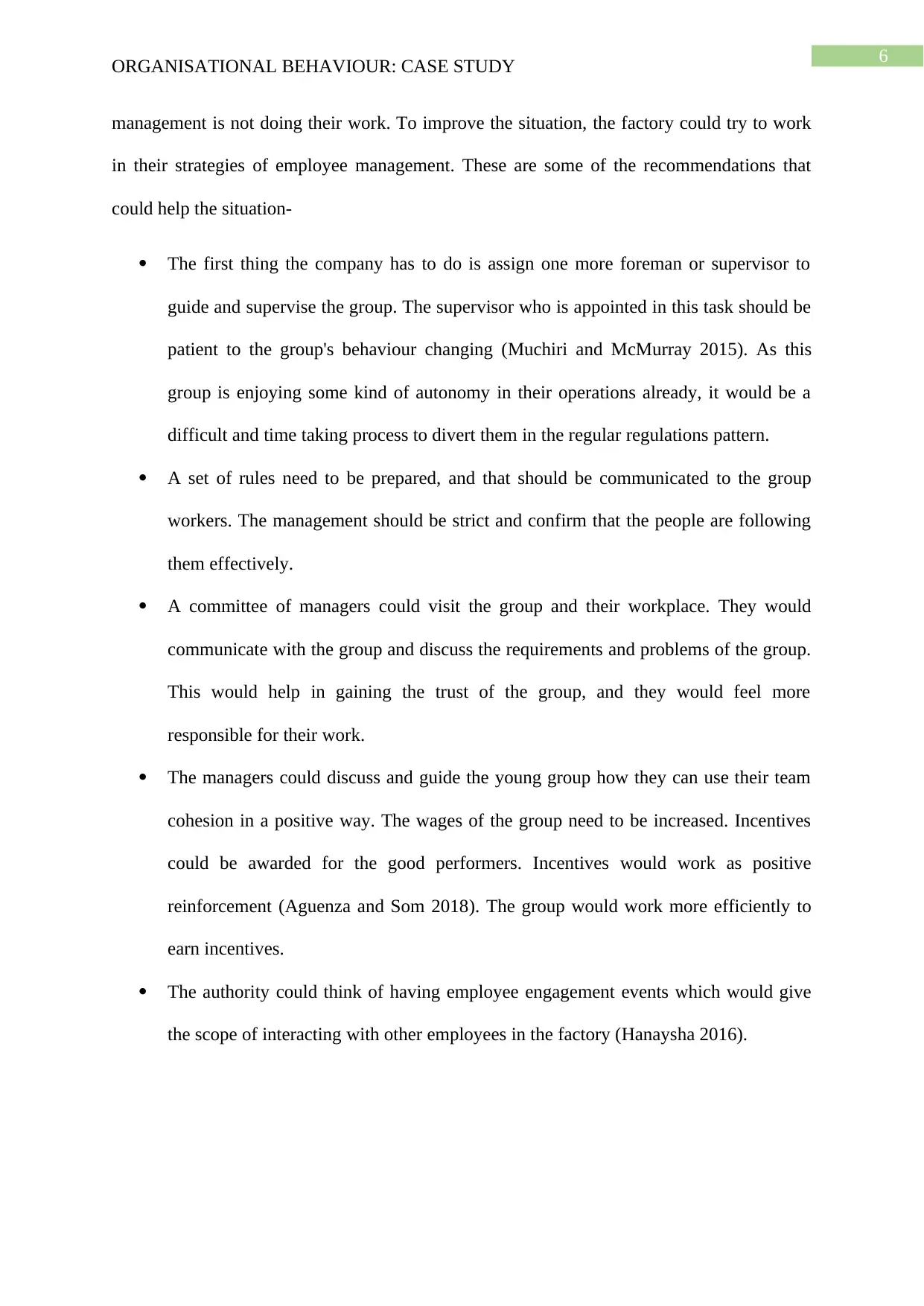
6
ORGANISATIONAL BEHAVIOUR: CASE STUDY
management is not doing their work. To improve the situation, the factory could try to work
in their strategies of employee management. These are some of the recommendations that
could help the situation-
The first thing the company has to do is assign one more foreman or supervisor to
guide and supervise the group. The supervisor who is appointed in this task should be
patient to the group's behaviour changing (Muchiri and McMurray 2015). As this
group is enjoying some kind of autonomy in their operations already, it would be a
difficult and time taking process to divert them in the regular regulations pattern.
A set of rules need to be prepared, and that should be communicated to the group
workers. The management should be strict and confirm that the people are following
them effectively.
A committee of managers could visit the group and their workplace. They would
communicate with the group and discuss the requirements and problems of the group.
This would help in gaining the trust of the group, and they would feel more
responsible for their work.
The managers could discuss and guide the young group how they can use their team
cohesion in a positive way. The wages of the group need to be increased. Incentives
could be awarded for the good performers. Incentives would work as positive
reinforcement (Aguenza and Som 2018). The group would work more efficiently to
earn incentives.
The authority could think of having employee engagement events which would give
the scope of interacting with other employees in the factory (Hanaysha 2016).
ORGANISATIONAL BEHAVIOUR: CASE STUDY
management is not doing their work. To improve the situation, the factory could try to work
in their strategies of employee management. These are some of the recommendations that
could help the situation-
The first thing the company has to do is assign one more foreman or supervisor to
guide and supervise the group. The supervisor who is appointed in this task should be
patient to the group's behaviour changing (Muchiri and McMurray 2015). As this
group is enjoying some kind of autonomy in their operations already, it would be a
difficult and time taking process to divert them in the regular regulations pattern.
A set of rules need to be prepared, and that should be communicated to the group
workers. The management should be strict and confirm that the people are following
them effectively.
A committee of managers could visit the group and their workplace. They would
communicate with the group and discuss the requirements and problems of the group.
This would help in gaining the trust of the group, and they would feel more
responsible for their work.
The managers could discuss and guide the young group how they can use their team
cohesion in a positive way. The wages of the group need to be increased. Incentives
could be awarded for the good performers. Incentives would work as positive
reinforcement (Aguenza and Som 2018). The group would work more efficiently to
earn incentives.
The authority could think of having employee engagement events which would give
the scope of interacting with other employees in the factory (Hanaysha 2016).
Paraphrase This Document
Need a fresh take? Get an instant paraphrase of this document with our AI Paraphraser

7
ORGANISATIONAL BEHAVIOUR: CASE STUDY
References
Aguenza, B.B. and Som, A.P.M., 2018. Motivational factors of employee retention and
engagement in organisations. IJAME.
Bakotić, D., 2016. Relationship between job satisfaction and organisational performance.
Economic research-Ekonomska istraživanja, 29(1), pp.118-130.
Hanaysha, J., 2016. Testing the effects of employee engagement, work environment, and
organisational learning on organisational commitment. Procedia-Social and Behavioral
Sciences, 229, pp.289-297.
King, D. and Lawley, S., 2016. Organisational behaviour. Oxford University Press.
Muchiri, M. and McMurray, A., 2015. Entrepreneurial orientation within small firms: A
critical review of why leadership and contextual factors matter. Small Enterprise Research,
22(1), pp.17-31.
Osland, J., Devine, K. and Turner, M., 2015. Organisational behavior. Wiley Encyclopedia of
Management, pp.1-5.
Saintilan, P. and Schreiber, D., 2017. Managing organisations in the creative economy:
organisational behaviour for the cultural sector. Routledge.
Wilson, F.M., 2018. Organisational behaviour and work: a critical introduction. Oxford
university press.
ORGANISATIONAL BEHAVIOUR: CASE STUDY
References
Aguenza, B.B. and Som, A.P.M., 2018. Motivational factors of employee retention and
engagement in organisations. IJAME.
Bakotić, D., 2016. Relationship between job satisfaction and organisational performance.
Economic research-Ekonomska istraživanja, 29(1), pp.118-130.
Hanaysha, J., 2016. Testing the effects of employee engagement, work environment, and
organisational learning on organisational commitment. Procedia-Social and Behavioral
Sciences, 229, pp.289-297.
King, D. and Lawley, S., 2016. Organisational behaviour. Oxford University Press.
Muchiri, M. and McMurray, A., 2015. Entrepreneurial orientation within small firms: A
critical review of why leadership and contextual factors matter. Small Enterprise Research,
22(1), pp.17-31.
Osland, J., Devine, K. and Turner, M., 2015. Organisational behavior. Wiley Encyclopedia of
Management, pp.1-5.
Saintilan, P. and Schreiber, D., 2017. Managing organisations in the creative economy:
organisational behaviour for the cultural sector. Routledge.
Wilson, F.M., 2018. Organisational behaviour and work: a critical introduction. Oxford
university press.
1 out of 8
Related Documents
Your All-in-One AI-Powered Toolkit for Academic Success.
+13062052269
info@desklib.com
Available 24*7 on WhatsApp / Email
![[object Object]](/_next/static/media/star-bottom.7253800d.svg)
Unlock your academic potential
Copyright © 2020–2025 A2Z Services. All Rights Reserved. Developed and managed by ZUCOL.



